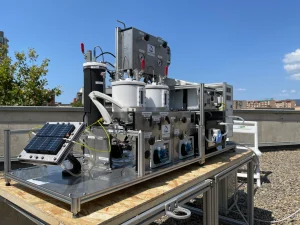
The LESGO prototype is ready to start running
The prototype will allow researchers to demonstrate the project concept in preparation for system validation.
June 25, 2023
After a process of 3D modelling and several iterations to solve issues related to the procurement of materials and equipment, LESGO’s researchers finished assembling the first industrial prototype of LESGO’s technology, allowing the validation of the graphene oxide hydrogenation by using solar energy as a renewable energy source for long-term energy storage. Set up at the IREC facilities, the prototype will start running in the upcoming weeks, allowing researchers to demonstrate and optimize the project concept.
The development of LESGO’s industrial prototype is a collaborative effort among several partners of the consortium responsible for developing and implementing its different parts. Hysytech R&D engineer Freddy Liendo travelled to Barcelona to assist in the installation and commissioning of the prototype, training IREC researchers, who had previously computed and modelled the fluid dynamics, into operating the system. During the day of the prototype assembly, ICFO‘s team also integrated the PV panels to power the electrochemical cell, while the SEMS team at IREC integrated the RAMAN system to be used to monitor in real-time the hydrogenation process of graphene oxide (a system that is set to be patented).

“There has been excellent communication among the different partners – IREC, ICFO and AALTO, for the development and assembly of the prototype”, highlights Freddy. “The integration of the different components involved not only the technical part, such as defining the process parameters for selecting the materials or the instrumentation, but also designing the final layout of the prototype.”
The prototype is expected to work under different process conditions, allowing the monitoring and storage of process data to make a detailed evaluation of the project concept. Moreover, integrating solar energy as the energy source will help demonstrate its economic and environmental feasibility.
This project has received funding from the European Union’s Horizon 2020 research and innovation programme under grant agreement No 952068 (H2020-FETPROACT-2019-2020 / H2020-EIC-FETPROACT-2019).